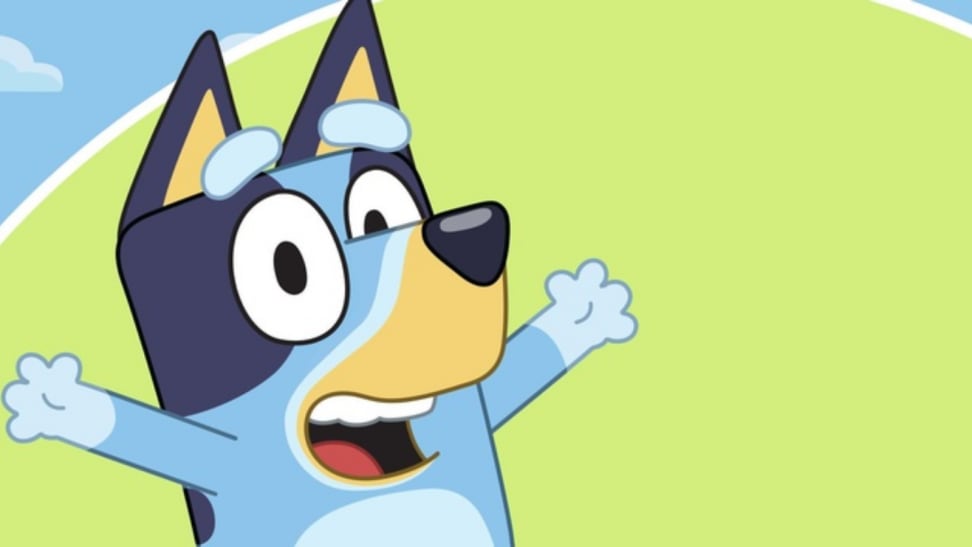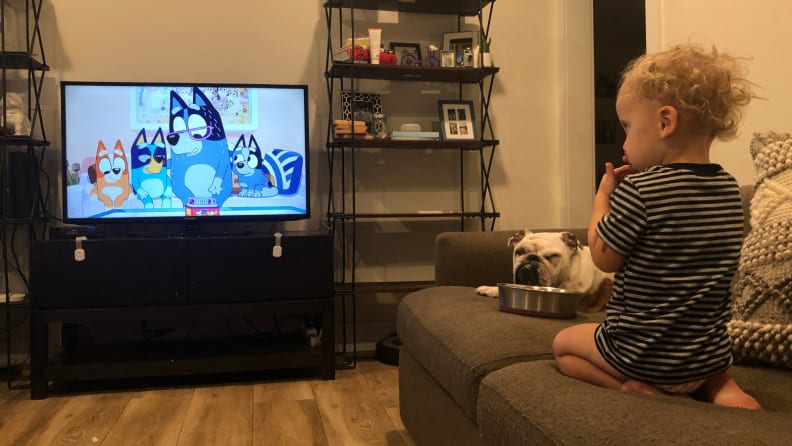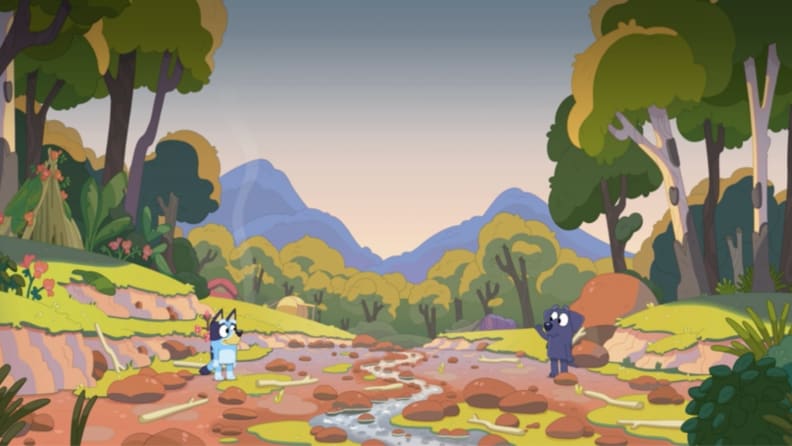This popular show on Disney+ made me a better father—here's why
Bluey has become a household staple for us.
 Credit:
Disney
Credit:
Disney
Products are chosen independently by our editors. Purchases made through our links may earn us a commission.
On our worst days and in our lowest moments while we're parenting through the pandemic, my wife and I sometimes find ourselves wondering if our kids would be better off being raised by dogs.
Not just any dogs, though: Chili and Bandit Heeler.
And while I can’t speak for how well Bandit handles lags in the unemployment system or Chili’s breaking point when it comes to customer service hold times, it’s a safe bet that every adult with kids at home right now (and even those with an empty roost) could learn a thing or two about patience and parenting from "Bluey".
As a father of two, I’ve seen my share of kids programming over the past several years, and I could easily rattle off a few erstwhile shows that give good TV a bad name—and a number that are worth your time. But never has a program captured my attention quite like “Bluey,” which has rocketed to the top of my Kids Show Power Rankings amid our summer-long quarantine binge.
What is Bluey about?
If you’re not familiar with “Bluey”—a breakout hit on Disney+ that counts Lin-Manuel Miranda among its fans—the show focuses on the Heelers, a family of anthropomorphic Australian cattle dogs living in Brisbane: Chili, Bandit, 6-year-old Bluey, and her 4-year-old sister, Bingo.
Each episode of the animated series, created by Joe Brumm and produced by Brisbane-based Ludo Studio, clocks in at a digestible seven minutes long (or three to a typical 30-minute TV block), and most focus on a lesson or theme that is central to the childhood experience—although the path to the moral of the story in this zany program is very rarely a straight line.
Why I'm obsessed with Bluey

Even our dog loves watching Bluey.
There are a lot of things that stand out about "Bluey," not the least of which is the animation, itself, which is superb. The attention to detail is also notable throughout, particularly when it comes to the subtle reminders that these dogs are, after all, dogs. (Bluey lamenting that she “hasn’t learned how to shake yet” when Bandit forgets to bring towels on a day at Uncle Stripe’s pool is just one of many examples.)
But the show's ultimate redeeming quality is the overwhelmingly human nature of its characters and the resulting role a silly cartoon has played in helping my entire household become more accountable for how we treat each other — kids and adults, alike. For parents struggling with little ones at home, "Bluey" is a delightful, relatable reminder of the value of being a great team, and the level of imagination we should all hope to inspire in our children.
It’s for kids of all ages...
When it comes to my 7-year-old daughter, my 2-year-old son, and their respective tastes in TV shows, the center of the Venn diagram can be tough to find—and might be non-existent if not for “Bluey.” But somehow, some way, this show defies the odds. Regardless of whose Disney+ avatar is doing the driving within the app (our son’s, of course, is the show’s titular hero), “Bluey” is at the top of the watch list, a credit to how in tune the show is with its audience.
The list of reasons why “Bluey” appeals to such a diverse range of viewers is long, but ultimately, it offers a realistic depiction of life in a modern home, and our kids deserve credit for recognizing it, even if they can’t articulate it. Better than any show I’ve come across, “Bluey” captures how life makes kids feel, rather than presenting it as a series of events that happen to them, and when a program can tug at a 7-year-old’s heartstrings, you know you’ve found a winner.
...including Mom and Dad
It’s always refreshing when a kids show is drafted with parents in mind, and “Bluey” is no exception. Simply put, the writing is sharp and the jokes are funny, regardless of the viewer’s age. But while there is no shortage of juvenile humor—I can’t help but get a kick out of Bandit’s persistent sauerkraut burps in the “Chickenrat” episode, myself—the show also doubles as a playbook on how to tackle challenging issues with kids of a certain age. “Mums and Dads” and “Bumpy and the Wise Old Wolfhound” are just a few examples of episodes that take important topics like gender roles, bullying and going to the hospital and distill them so kids can comprehend the message.
To that end, “What would Bandit do?” has actually become a mantra of sorts in my house over the past few months—and one that doesn’t just apply to my kids. In fact, one of the most striking things about “Bluey” is the way it depicts the relationship between parents Bandit and Chili. The definition of couple goals, the Heelers are as patient with each other as they are with their pups, despite the insanity that surrounds them. It’s a connection every couple should aspire to, and while I’m no Bandit, there’s certainly no shame in trying my best to emulate him.
The games are incredible
Often, an episode of “Bluey” will focus on a game the pups are playing to pass the time, and virtually all of them are a hoot, with “Magic Xylophone”—in which Bandit must freeze in place every time someone plays a note on a xylophone—setting the tone in the premiere episode of Season 1.
From "Keepy-Uppy" to "Fairies" to "Shadowlands," the games Bluey and Bingo play with their friends and family are amazingly creative, and Season 2 (available on Disney NOW as it airs on TV) has more where that came from, starting with “Dance Mode” and “Featherwand” in the first two episodes. So sure, you can do your best to try to keep your kids from catching on and wanting to imitate what they’re seeing on TV, but take it from me: Once you turn on “Bluey,” it’ll only be a matter of time before someone is asking you to play "Asparagus” at the dinner table.
It comes from the heart
In my favorite episode, titled “Camping,” Bluey and her family take a camping trip, and while on holiday, Bluey befriends a French-speaking black lab named Jean Luc, whose family is posted up in a neighboring tent. Over the course of several days, Bluey and Jean Luc become fast friends, despite Jean Luc only speaking in his native tongue. The only time the language barrier comes into play is on Jean Luc’s last night at the campsite, when Jean Luc responds to Bluey’s “See you tomorrow,” with a somber, “Non, pas demain matin” (“No, not tomorrow morning”) as Bluey squeals obliviously with delight on the way back to her tent.
You can guess where the episode goes from there (or at least you probably think you can), and it’s one of many examples (along with “The Dump,” “Fruitbat” and others) of how “Bluey” can leave you verklempt in a way you never imagined a 7-minute cartoon could. So perhaps it’s appropriate that one of Bluey’s catch-phrases throughout the show is, “for real life?”—an exclamation typically used in response to something that seems too good to be true. Because in the case of “Bluey,” there’s an authenticity that leaves viewers feeling like Bluey’s real life could be any one of theirs, and that’s what makes it so easy to love.
How to watch Bluey on Disney+

"Camping" is my favorite episode of Bluey.
A Disney+ subscription can be purchased using a host of different devices at a cost of $6.99 per month or $69.99 for the year, and by year’s end the Disney+ library will include more than 500 movie titles and 7,000 TV shows. Episodes of "Bluey" can be found using the search bar within the app, with 51 episodes from Season 1 available to watch today.
